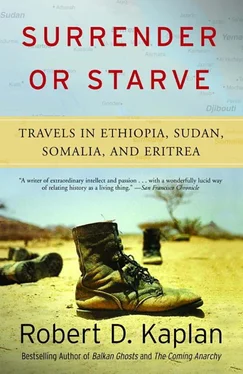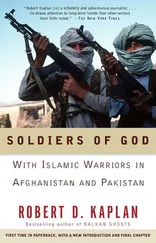As the die was about to be cast, the Dergue still was maintaining contact with Israel, which had just elected a new prime minister, Menachem Begin. One of Begin’s first acts was to communicate with Mengistu about the plight of Ethiopia’s black Falasha Jews. This led to a series of messages whereby the Ethiopians made it known to the Israelis that they still desired a “Western option.” In June, the long-awaited Somali invasion of Ethiopia’s Ogaden desert began; regular Somali army units crossed the border to support WSLF guerrillas. Despite clandestine Israeli assistance and the new Soviet equipment, which had just begun to arrive, the Dergue, which also was occupied with fighting in Tigre and Eritrea, was not strong enough to stop the Somali advance. When Begin met Carter in Washington in July and urged him not to close the door completely in Ethiopia, Mengistu was in desperate straits and very well may have been amenable to certain U.S. demands on human rights and other issues if Carter was willing to resume, albeit on a low level, the military aid relationship. There was no question of blackmail. This was not Iran. Ethiopia never had taken any foreign hostages, and its revolution—leftist although it was and Mengistu’s diatribes notwithstanding—was relatively devoid of anti-U.S. sentiment, despite previous U.S. support for Haile Selassie. The United States thus had no axe to grind against Ethiopia when Begin offered Carter a second chance to salvage some degree of U.S. influence in black Africa’s second most populous nation. But Carter rejected the Israeli leader’s advice.
Carter very well may have felt that considering the growing Eastern-bloc arms commitment to the Dergue, Mengistu was likely to take U.S. weapons without giving anything back in the way of policy concessions. But nor was Carter willing to put U.S. weapons in the hands of the Somalis as an alternate means of pressuring the Dergue. After all, through their own hell-bent irredentism, the Somalis now were providing Carter with yet another opportunity to muddle the outcome of Moscow’s Ethiopia gambit. Apparently to placate Brzezinski, Carter did give General Siad indications that the United States was willing to supply arms. But by August, when Somali troops were on the verge of overrunning Jijiga, fifty miles inside Ethiopia, the United States announced that so long as Somali troops were illegally occupying Ethiopian territory, Washington could not supply them with arms. The Soviets were less legalistic. They brought in Cuban and South Yemeni troops to slow the Somali advance while at the same time resuming arms supplies to Somalia and inviting General Siad to Moscow.
The Moscow meeting was a failure, however. The Somali leader, under pressure from his own conquering army and WSLF guerrillas, could not simply withdraw in order to accommodate Soviet strategy in Ethiopia. On November 13, 1977, the Somalis expelled their Soviet advisers and broke diplomatic relations with Cuba. Later in the month, the Soviets began airlifting thousands of Cuban troops to Ethiopia. During the next four months, as Tom Farer reported in War Clouds on the Horn of Africa, Moscow would deliver more than $1 billion worth of arms to Ethiopia, which was more than four times the value of all the arms the United States had delivered to the country since 1953.
The Somalis had no choice but to come running to the United States. “We advised them,” related Vance in his book, “to accept OAU [Organization of African Unity] mediation of their dispute with Ethiopia, to seek a negotiated peace, and to offer their neighbors [Ethiopia and Kenya] assurances of respect for their territorial integrity.” (This was basically what Moscow was telling General Siad to do.) The administration was taking the easy way out: preaching the Western version of morality from the sidelines while the Soviets, by trial and error, were muscling their way toward control over tens of millions of people.
At the beginning of 1978, the influx of Soviet arms and Cuban soldiers finally was taking effect. The Somalis were weakening. If the Ethiopians managed to completely eject Somali forces from the Ogaden, coupled with improved military fortunes in Eritrea, it would mean the consolidation of Mengistu’s power and that of the Kremlin’s in Ethiopia—an incredible display of Soviet military strength and determination in support of an ally. In this desperate moment, the administration, according to Vance, was only “prepared to support Somalia in a limited way, including the supplying of defensive arms, but only after the Somalis withdrew from the Ogaden.” It was a classic example of the West being too civilized to defend its own values and interests. However badly the Soviets may have looked for deserting Somalia after building it up into a regional power, at least they were acting in support of their interests.
At this point, Brzezinski was urging several available options on President Carter, including deploying the U.S. Navy in the region, providing air cover for Somali troops, giving military aid to the Somalis and Eritreans, and linking Soviet behavior in the Horn to progress on the Strategic Arms Limitation Talks. None of these occurred. In his book, Vance outlined the strategy that took shape in early February.
• First, to work with our NATO allies to achieve agreed Western goals: a negotiated settlement; preventing an invasion of Somalia; preventing an increase in Soviet and Cuban influence in the area.
• Second, to ensure that other friends in the region—Egypt, Iran, Saudi Arabia, and Sudan—also understood and supported these goals and would urge them on Siad Barre.
• Third, to obtain Somali agreement to withdraw from the Ogaden.
• Fourth, to lay the diplomatic and political groundwork to help Somalia defend its territory, including supplying defensive arms after it withdrew from the Ogaden.
• Fifth, to keep pressure on the Soviets to stop the Ethiopians and Cubans at the Somali border and to support a negotiated resolution.
In other words, do little.
First, Soviet influence had grown so much in the region that the issue was how to reduce it, not to accept it at the present level as Vance indicated. Second, the “other friends” were nearly as powerless as was the United States in the face of a massive Soviet airlift of weapons and Cuban troops. Third, whether the Somalis agreed to withdraw from the Ogaden or not, the Ethiopians, Cubans, and Soviets were about to use force to kick the Somalis out. Fourth and fifth, the defensive arms that the United States eventually would provide General Siad were beside the point: the Soviets had no need for Ethiopia to invade Somalia because their position in Ethiopia would be secured merely by driving the Somalis out of Ethiopia and by turning the tide against the Eritrean guerrillas.
In mid-February 1978, the Ethiopians, fortified by Cuban armor, counterattacked. Somali forces were outflanked, and Jijiga was retaken by the Dergue on March 9. Farer wrote in his book that “President Carter practically simultaneously announced” the decision by the Somali government to remove all its troops from Ethiopia. One could say that it was a rare case of one superpower leader announcing a victory of the other. Vance still was not satisfied, however. Even after Somalia had withdrawn its troops, the United States, according to Vance, still was “not able to assist Somalia militarily at that time because Siad Barre reneged on his assurances that he would leave Ethiopia alone.” Had the Kremlin been able to draft the script, it couldn’t have done a better job.
The superpower flip-flop in the Horn of Africa now was complete. It was by no means a fair trade—either for the United States or for the people of the region. Instead of controlling a country of three million people whose nomadic lifestyle they virtually left alone, the Soviets now had control over a country of more than 30 million people, whose existences would be trampled on in the course of implementing communism. Although U.S. ideology had helped to restrain some of Haile Selassie’s excesses, Soviet ideology would serve to intensify the worst excesses of the Dergue. In Breakfast in Hell, relief worker Myles F. Harris described the difference between the two Ethiopian regimes.
Читать дальше












